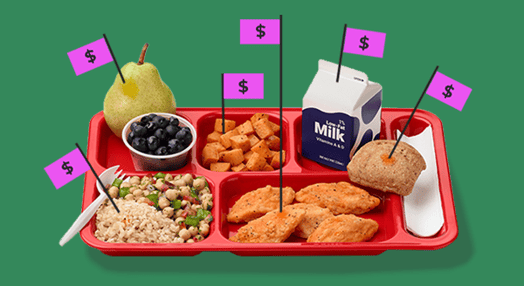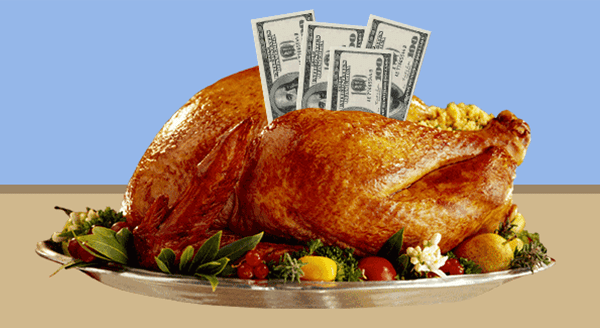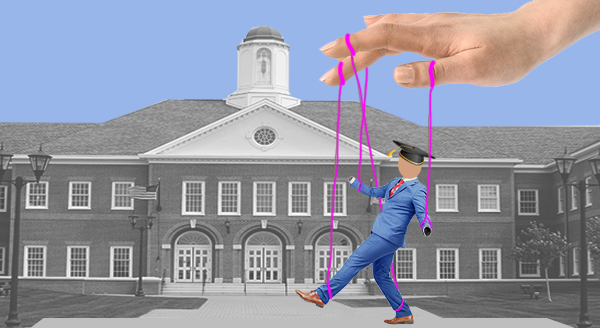American schools spend ~$900B a year on education. Should the federal government pay more for meals?

When Kathy Alexander started managing a lunch program at a Vermont school with 200 children in the late 1990s, she was shocked by how much the cafeteria felt like a business.
Her staff spent significant amounts of time on paperwork to track students’ incomes and collected money from kids at a cash register. They faced grueling decisions over whether they should raise prices and calculated the debts of families who barely missed out on eligibility for discounted meals yet struggled to pay the full price.
“Within a year I said to myself, ‘This is insane.’ What is happening? Why do I have to run this business in this school?” Alexander says.
Decades later, the model for Alexander, who’s now the director of the food service cooperative in the Mt. Abraham United School District, has changed. Vermont is one of eight states providing universal free meals to public K-12 students rather than charging different price points based on income. In lieu of onerous administrative work, Alexander’s staff spends more time brainstorming how to maximize federal dollars to support the program and trying out new recipes for pulled pork flatbread with pineapple sauce and Vietnamese rice bowls.
She wants universal free lunch to “sweep the country.”
The idea, which gained traction after all school meals were temporarily made free during the pandemic, is broadly popular. As of last fall, according to a YouGov poll, 60% of Americans supported universal free lunch. While Independents and Democrats liked it more than Republicans — VP candidate Tim Walz has made it an economic talking point this election season — nearly half of GOP-leaning voters were supportive.
Olivia Heller/The Hustle
In public schools where everyone gets supplied with free books and buses and desks, why has lunch never been considered the same way? Would the extra costs — that critics say would, in part, subsidize food for children from affluent families — be worth it?
The business model of lunch
The first national school lunch programs were started in the 1930s to correct a supply problem.
- During the Great Depression, with millions of poor Americans unable to afford food, farmers had a surplus of crops.
- Children, meanwhile, starved as their families struggled to make ends meet.
So the federal government, working in coordination with local school districts and community leaders, purchased fresh food from the farmers’ surplus harvests and used it for school lunches.
By 1937, the school lunch program served ~500k meals at ~10k schools daily, while also providing thousands of jobs through the Works Progress Administration. Some local districts charged around two cents per meal or asked parents to pitch in food supplies, but some served everyone for free regardless of income.
“The school lunch projects were originally intended to serve only children from relief families, but experience taught that growing children need a hot mid-day meal irrespective of their financial condition,” wrote Ellen Woodward, who helped oversee the national program in the 1930s.
A boy eats free lunch in 1938. (Bettman via Getty Images)
In 1946, President Harry Truman formalized school lunch programs through the National School Lunch Act.
The system has evolved over the years — expanding and shrinking based on political whims — but the model has largely stayed the same: the federal government reimburses local school districts to provide lunch (and breakfast, through the School Breakfast Program).
- Some 30m children receive school lunches per year with ~94% of American schools — including private and public — participating in the program.
- Roughly half of America’s public school students are eligible for free or reduced lunch based on their family’s income being at or below 185% of the federal poverty level ($57.7k for a family of four in 2024). The rest pay full price for the meal.
- The schools get reimbursed ~$0.40-$0.50 for every meal provided to a full-paying student in the 2024 school year and ~$4-$4.50 per meal for a free or reduced-price student meal — adding up to a federal cost of ~$17B in 2023, when 4.6B lunches were served.
That sum makes it the second-largest food and nutrition assistance program in the US. But surveys indicate that 57% of schools don’t take in enough reimbursement to cover the food, supplies, and labor necessary to cook and serve lunch. Schools say they’d need about an extra 49 cents per meal to cover their costs.
Olivia Heller/The Hustle
Faced with these challenges, a regular business would likely lower costs (and potentially quality) or raise prices on the students who are ineligible for free or reduced meals. But schools must meet federal nutrition standards, and price hikes are complicated given the precarious incomes of many families.
In fact, many students who must pay full price for lunch come from families who struggle to afford it.
The costs and benefits of going free
For years in Vermont, as in the rest of the country, not everyone who would have benefitted from a free lunch got one. During the 2022-23 school year, there were thousands of families making more than the income ceiling for free or reduced lunch eligibility but not enough to afford the full-priced lunches, according to Anore Horton, executive director of Hunger Free Vermont.
The state calculated that a family of four in Vermont needed to make $108k annually to cover basic needs, such as food and clothing and transportation. Yet the free or reduced lunch cutoff was a little over $50k, putting some 32k students (more than 35% of all school-aged children) in a so-called “missing middle” that was above the free lunch cutoff but below the income sufficient for covering basic needs.
Olivia Heller/The Hustle
These families’ struggles to afford lunch showed up as unpaid meal debt, which Horton says totaled ~$3m annually in Vermont. In the US, annual unpaid debts owed for school meals have been estimated at ~$262m.
In Vermont, state taxpayers ended up picking up the tab for the unpaid debts — same as they did for whatever the schools owed beyond the reimbursements they received from the federal government. Although district accounting practices don’t provide a clear view of these latter costs, Horton estimated a statewide cost of millions more dollars.
In 2023, Vermont passed a bill mandating universal free lunch for public schools. All school children can now get lunch for free regardless of income.
Instead of being reimbursed for meals at a varying rate, schools are reimbursed ~$4-$4.50 for every meal served, with Vermont covering the difference beyond what the federal government provides.
The state budgeted $29m for its coverage in 2023-2024 — likely higher than what it had previously owed for unpaid lunch debts and other expenses. Opponents say this extra cost for state taxpayers means that poorer families, which already receive free or reduced price meals, are subsidizing wealthier families that start eating the free meals. When California switched to universal free meals, the San Luis Coastal Unified District in central California saw the amount of breakfast and lunch it serves double.
Critics also point to examples of fraud with lunch programs as reasons not to further invest in them.
And in the end, shifting to free lunch doesn’t fix all the financial problems local schools face with meal production. Food and labor are still expensive, and the reimbursements, be they from the state or federal government, typically aren’t enough to cover all their costs.
But advocates say free lunch helps schools and stimulates the economy in other ways:
- Schools have more consistency and control with their budgets. At the same time, because of increased efficiency, per-meal expenses go down as more children opt for lunch.
- Schools with universal free lunch have also been found to serve more local food, leading to more business for area suppliers.
With everyone getting free lunch, “missing middle” families now benefit, too.
Elementary school students in Arlington, Virginia, peruse fresh vegetables in the cafeteria. (HUM Images via Getty Images)
Take that California district that saw double the meals served for example. According to data from the National Center for Education Statistics, roughly 34% of San Luis Coastal Unified students have incomes below the national threshold for receiving free or reduced lunch. But the median household income for the district is ~$80k, lower than the state’s median, suggesting a high proportion of middle-income students who’d benefit from the universal free meals.
The missing middle families that save money on lunch have room to spend on other necessities.
“That’s one of the most powerful arguments, I think, for universal school meals,” Horton says. “There isn’t any other really efficient or effective way to reach those children if you don’t go to a universal model.”
The Rockefeller Foundation, a philanthropic organization, found current US free lunch programs generated about $40B in economic gains at a cost of less than $20B because the free meals helped alleviate poverty and improved health outcomes. It recommends universal free meals, expecting a similar return on investment and believing that lunch shouldn’t be different from any of the other mainstays universally provided at schools.
“We don’t ask them to pay for their school books. We don't ask them to pay for the laptop or the materials that are distributed to all children as part of their learning, as part of their school day,” says Noah Cohen-Cline, director of the Rockefeller Institute’s food initiative. “And I see school food the same way…It’s a foundation for learning.”
Outside the classroom expenses
Until recently, the idea of investing in programs tangential to learning had largely been absent from school budget discussions. School lunch was like “a no man’s land,” says Amy Ellen Schwartz, a professor of public policy at the University of Delaware who’s studied lunch programs. “People would say principals are instructional leaders…and all money that doesn’t go into the classroom is inefficient and wasted.”
While studying middle schoolers at New York public schools with universal free lunch and breakfast through a Community Eligibility Program, Schwartz and Michah Rothbart, a public administration and international affairs professor at Syracuse University, discovered what might be the biggest benefit for universal meals. They found that universal free meals led to higher test scores. The increase wasn’t just among low-income children, it was also among students who’d otherwise not receive free lunch.
Olivia Heller/The Hustle
In 2020-21, US schools spent ~$900B on K-12 public education, or $18.6k per student, a sum that includes everything from teacher salaries to buses to supplies. If they’re not investing enough in lunch, Schwartz believes the rest of the spending won’t go as far as it could.
“Hungry kids don’t pay attention,” Schwartz says. “Hungry kids can’t learn.”











